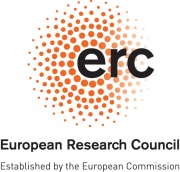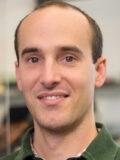CTFM Chair
Chair 'Chemistry of Thin Film Materials'
Research Focus
 Research in the chair ‘Chemistry of Thin Film Materials’ focuses on the development of preparative methods for nanostructured inorganic materials and interfaces at which various types of energy conversion phenomena can be studied. We create inorganic nanoparticles and nanostructures with accurately tunable geometry, and we study their physical and chemical properties systematically as they vary with the geometric parameters. We are particularly interested in the transport and exchange of electrons and ions at interfaces in solar cells, batteries, and other electrodes. We are part of FAU’s ‘Interdisciplinary Center for Nanostructured Films’ (IZNF).
Research in the chair ‘Chemistry of Thin Film Materials’ focuses on the development of preparative methods for nanostructured inorganic materials and interfaces at which various types of energy conversion phenomena can be studied. We create inorganic nanoparticles and nanostructures with accurately tunable geometry, and we study their physical and chemical properties systematically as they vary with the geometric parameters. We are particularly interested in the transport and exchange of electrons and ions at interfaces in solar cells, batteries, and other electrodes. We are part of FAU’s ‘Interdisciplinary Center for Nanostructured Films’ (IZNF).
Research activities are carried in two groups led by Prof. Julien Bachmann and Dr. Ryan Crisp.
News ― BlueSky feed (Twitter / X no longer in use)
Prof. Dr. Julien Bachmann
Section
Materials Chemistry
Research areas
Molecular materials:
Energy
Nanostructured interfaces for charge transfer
Extremely thin absorber solar cells
Electrocatalysis and photoelectrocatalysis
Solar batteries
Thin functional coatings: semiconductors, catalysts
Molecular materials:
Information
Atomic layer processing: designer reagents for precision solid deposition
Molecular materials:
Sustainability
Atomic layer processing: precision solid deposition in mild conditions
Atomic-layer additive manufacturing
Member of:
Dr. Ryan Crisp
Section
Materials Chemistry
Research areas
Molecular materials:
Energy
Nanomaterials for solar-to-X
Molecular materials:
Sustainability
New optoelectronics development with non-critical materials
Photochemical degradation mechanisms of PFAS
Our commitment
Members of the CTFM chair are committed to fostering an inclusive and equitable environment in our laboratory, where all have the opportunity to reach their highest potential as scientists and people. We believe that a diversity of skills, perspectives, and experiences is critical to the success of our research and constitutes our greatest strength as a group. We welcome and value researchers of any ethnicity, religion, national origin, gender identity, sexual orientation, physical ability, socioeconomic status, age and more. Our goal is to create and maintain a culture such that each member of the group feels they belong and each can flourish. This culture is achieved through tailored mentorship, interdisciplinary learning, and a collaborative atmosphere. We are committed to promoting these values of inclusivity and equity within the scientific community and beyond.
Selected sources of funding and collaborative projects
 |
BTHA project: BaCzALD: ‘Bavarian-Czech alliance for photoactive films by solution atomic layer deposition’ |
Bavarian-Czech Academic Agenc |
| EU H2020 projects:
• ‘Fast Track to Innovation’ consortium ‘Atoplot — the atomic layer 3D plotter‘ • ‘Factories of the Future’ consortium ‘MESOMORPH – All-in-one machine for hybrid technologies enabling high value added multi-scale integrated micro-optoelectronics’ (coordinated by Prima Industrie) |
 |
|
 |
• ERC Proof of Concept Grant: ‘ALAMS— Atomic-layer additive manufacturing for solar cells’ (2022-2023) • ERC Consolidator Grant: ‘Solacylin — A preparative approach to geometric effects in innovative solar cell types based on a nanocylindrical structure’ (2015-2021) |
 |
 |
EU COST Actions: • ‘RENEW-PV – Research and International Networking on Emerging Inorganic Chalcogenides for Photovoltaics’ (CA21148)• ‘NETPORE — Network for Research, Innovation and Product Development on Porous Semiconductors and Oxides’ (CA20126) |
 |
 |
DFG projects:
• ‘Solar Reduction of CO2 at Nano-Architectured Photoelectrodes Featuring Advanced Photon Management’ (Ryan Crisp with Katarzyna Siuzdak at IMP PAN) • Coordinated Research Center ‘CLINT’ — ‘Catalysis at liquid interfaces’ • ‘Catalytic and electrochemical release of solar energy stored in strained organic compounds’ • ‘Chemistry for 3D spintronics’ (DFG-ANR, 2018-2022: • ‘Investigation of factors that affect the stability of composite electrode |
German National Science Foundation (DFG) |
 |
EAM Starting Grant (2013-2014) | Research cluster and Competence Unit ‘Engineering of Advanced Materials’ (EAM) and ‘New Materials and Processes’ (NMP) |
 |
BMBF projects
• ‘Tubulyze‘ • ‘ECO2nvert — Electroenzymatic CO2 reduction using recombinant CODHs from • ‘TubulAir’ |
 |
Legal note (‘Impressum’, in German)



